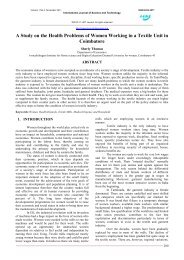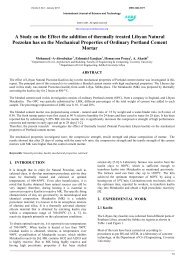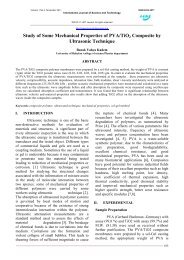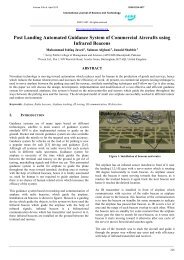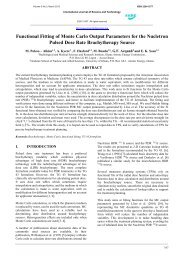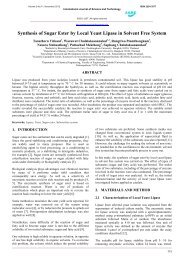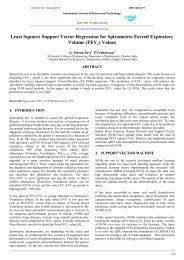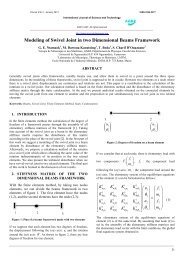Energy and Exergy Analysis for Single and Parallel Flow Double ...
Energy and Exergy Analysis for Single and Parallel Flow Double ...
Energy and Exergy Analysis for Single and Parallel Flow Double ...
You also want an ePaper? Increase the reach of your titles
YUMPU automatically turns print PDFs into web optimized ePapers that Google loves.
Volume 2 No.2, February 2012 ISSN 2224-3577<br />
International Journal of Science <strong>and</strong> Technology<br />
©2012 IJST. All rights reserved<br />
http://www.ejournalofsciences.org<br />
<strong>Energy</strong> <strong>and</strong> <strong>Exergy</strong> <strong>Analysis</strong> <strong>for</strong> <strong>Single</strong> <strong>and</strong> <strong>Parallel</strong> <strong>Flow</strong> <strong>Double</strong> Effect<br />
Water-Lithium Bromide Vapor Absorption Systems<br />
A.I.Shahata , M. M. Aboelazm, A. F. Elsafty<br />
Mechanical Engineering Department, Arab Academy <strong>for</strong> Science, Technology, Alex<strong>and</strong>ria, Egypt<br />
ABSTRACT<br />
The prices of energy have been increasing exponentially worldwide <strong>and</strong> industrial refrigeration is one of the<br />
most energy consuming sector. Absorption refrigeration systems are an alternative to vapor compression<br />
systems due to the increase of the environmental problems <strong>and</strong> electricity cost. In recent years, research has<br />
been increased to improve the per<strong>for</strong>mance of the absorption systems <strong>and</strong> the main way of improving efficiency<br />
is through thermodynamic analysis <strong>and</strong> optimization. <strong>Energy</strong> <strong>and</strong> exergy analysis of single <strong>and</strong> double effect<br />
systems is presented. The effect of different component temperature on the COP <strong>and</strong> exergetic efficiency is<br />
calculated. The results showed that the maximum COP <strong>and</strong> exergetic efficiency is achieved at lower values of<br />
the generator& the absorber temperature <strong>for</strong> both systems. The absorber temperature has the highest effect on<br />
the COP <strong>and</strong> energetic efficiency <strong>for</strong> both systems which shows that the absorber is the component that needs<br />
the improvement in design.<br />
Keywords: Absorption, Thermal analysis, <strong>Exergy</strong>, COP, Absorber<br />
1. INTRODUCTION<br />
Vapor absorption systems using water as the<br />
refrigerant <strong>and</strong> the lithium-bromide as the absorbent<br />
represent the simplest idea in absorption refrigeration<br />
technology <strong>and</strong> are assuming greater importance due to<br />
their environmentally friendly operation. The cost of these<br />
systems is dependent on whether they are single effect or<br />
double effect. This in turns depends on the application <strong>and</strong><br />
the source of heat available. [1].<br />
In recent years, interest in absorption systems has<br />
been growing because they use friendly refrigerants <strong>and</strong><br />
absorbents which don’t deplete the ozone layer. They use<br />
cheap alternative energy sources, such solar energy or a<br />
waste byproduct heat source helping in control of global<br />
warming. There<strong>for</strong>e, in recent years, research has been<br />
increased to improve the per<strong>for</strong>mance of the absorption<br />
refrigeration systems. The main way of improving<br />
efficiency is through thermodynamic analysis <strong>and</strong><br />
optimization. [2]<br />
In per<strong>for</strong>ming a thermodynamic analysis <strong>for</strong> a<br />
vapor absorption cycle, the principle of mass conservation<br />
<strong>and</strong> the first <strong>and</strong> second laws of thermodynamics are<br />
applied to individual components of the system. First <strong>and</strong><br />
second law analyses of absorption systems <strong>for</strong> cooling <strong>and</strong><br />
heating applications was also given by [3].<br />
The energy analysis approach is of limited use in view of<br />
the fact that it fails to determine the real losses in a<br />
refrigeration system. The A.I.Shahata , M. M.<br />
Aboelazm, A. F. Elsafty<br />
analysis is a novel approach based on the second<br />
law of thermodynamics which assists in evaluation of<br />
irreversibility occurring in the system at local <strong>and</strong> global<br />
levels. Various studies investigated the per<strong>for</strong>mance<br />
analysis of absorption refrigeration systems using the<br />
energy analysis method based on the first law of<br />
thermodynamics by means of the coefficient of<br />
per<strong>for</strong>mance (COP). [4]<br />
A modular computer code design was utilized to<br />
simulate the absorption systems <strong>and</strong> investigated the<br />
per<strong>for</strong>mance of single-effect cycle <strong>and</strong> various<br />
configurations of double-effect absorption refrigeration<br />
cycles using LiBr/H2O pair. [5]<br />
A steady state computer simulation model was<br />
developed to predict the per<strong>for</strong>mance of an ARS using<br />
LiBr/H2O as a working pair. [6]<br />
<strong>Exergy</strong> analyses have been made <strong>for</strong> absorption<br />
systems by different authors. A computer program was<br />
developed to predict the per<strong>for</strong>mance of an absorption<br />
refrigeration unit.[7] A single-stage refrigeration system<br />
operating with the water/lithium bromide mixture is<br />
optimized by making enthalpy <strong>and</strong> entropy balances in<br />
each one of the components of the system. An exergy<br />
analysis of double effect lithium bromide/water absorption<br />
refrigeration system was theoretically presented. [8]<br />
The exergy analysis is carried out <strong>for</strong> each<br />
component of the system. The results showed that the<br />
highest exergy loss occurs in the HPG, which there<strong>for</strong>e<br />
makes the HPG the most important component of the<br />
double effect refrigeration system. The first <strong>and</strong> second<br />
law of thermodynamics was used to analyze the<br />
per<strong>for</strong>mance of a single-stage water/ lithium bromide<br />
absorption refrigeration system. [4]<br />
85
Volume 2 No.2, February 2012 ISSN 2224-3577<br />
International Journal of Science <strong>and</strong> Technology<br />
©2012 IJST. All rights reserved<br />
http://www.ejournalofsciences.org<br />
The objective of this study is to develop a<br />
thermodynamic model including energy <strong>and</strong> exergy<br />
analyses <strong>for</strong> both single <strong>and</strong> parallel flow-double effect<br />
systems vapor absorption systems in order to determine<br />
which component has the great effect on the per<strong>for</strong>mance<br />
of the system.<br />
2. MODEL DESCRIPTION<br />
For thermodynamic analysis of the absorption<br />
system, the principles of mass conservation, first <strong>and</strong><br />
second laws of thermodynamics are applied to each<br />
component of the system. Each component can be treated<br />
as a control volume with inlet <strong>and</strong> outlet streams, heat<br />
transfer <strong>and</strong> work interactions. In the system, mass<br />
conservation includes the mass balance of the total mass<br />
<strong>and</strong> each material species (e.g. refrigerant <strong>and</strong> absorbent in<br />
an absorption cycle). The governing equations of mass <strong>and</strong><br />
type of material conservation <strong>for</strong> a steady state <strong>and</strong> steady<br />
flow system are given in equation (1&2) [7]:<br />
Mass Conservation:<br />
Figure (1) – single effect absorption cycle<br />
∑( m) - ∑( m) = 0 (1)<br />
in<br />
Species Conservation:<br />
∑( m.X) - ∑( m.X) = 0 (2)<br />
in<br />
out<br />
Where (m) is the mass flow rate <strong>and</strong> (X) is the<br />
mass fraction of Li-Br in the solution <strong>and</strong> the subscripts in<br />
<strong>and</strong> out are inlet <strong>and</strong> outlet flow in the control volume.<br />
The model solves the governing equations <strong>for</strong> the system’s<br />
components <strong>and</strong> incorporates the chemical <strong>and</strong><br />
thermodynamic properties of the water/lithium bromide<br />
solution. <strong>Single</strong> <strong>and</strong> double-effect systems configurations<br />
are shown in figures 1 <strong>and</strong> 2.<br />
out<br />
Figure (2) – parallel flow double effect absorption cycle<br />
2.1 First Law <strong>Analysis</strong> (<strong>Energy</strong> method)<br />
The first law of thermodynamics readily yields<br />
the energy balance of each component of the absorption<br />
system as follows (Conservation of energy):<br />
86
Volume 2 No.2, February 2012 ISSN 2224-3577<br />
International Journal of Science <strong>and</strong> Technology<br />
©2012 IJST. All rights reserved<br />
http://www.ejournalofsciences.org<br />
∑( mh) - ∑( mh) + [ ∑ Q - ∑ Q ] W = 0 (3)<br />
out in<br />
+<br />
out<br />
in<br />
Where the Q's are the heat transfer rates between<br />
the control volume <strong>and</strong> its environment, h is the specific<br />
enthalpy <strong>and</strong> W is the mechanical work transfer to or from<br />
the system. The heat balance over each component of the<br />
system gives the amount of the heat transfer to or from the<br />
component. Equations (4) to (9) represent the heat transfer<br />
<strong>for</strong> evaporator, condenser, absorber, generator, pump <strong>and</strong><br />
the heat exchanger respectively.<br />
So enthalpy data must be available <strong>for</strong> the<br />
working pair at all state points in the cycle. The enthalpies<br />
of the lithium bromide solution at the different points of<br />
the system are obtained in (kJ Kg-1) using the equations of<br />
the lithium bromide enthalpy-concentration diagram in<br />
t<strong>and</strong>em with the equations of the pressure-temperature<br />
equilibrium chart. [9]<br />
4<br />
4<br />
4<br />
n<br />
n 2<br />
X + t∑<br />
B X + t<br />
n<br />
n<br />
n=<br />
0 n=<br />
0<br />
n=<br />
0<br />
h = ∑ A<br />
∑C<br />
X<br />
n<br />
n<br />
(10)<br />
Where t is the lithium bromide solution<br />
temperature in oC <strong>and</strong> X is the concentration in % Li-Br.<br />
Equation (10) could be used <strong>for</strong> the concentration range<br />
40
Volume 2 No.2, February 2012 ISSN 2224-3577<br />
International Journal of Science <strong>and</strong> Technology<br />
©2012 IJST. All rights reserved<br />
http://www.ejournalofsciences.org<br />
associated with heat transferred Q from the source<br />
maintained at constant temperature T. The last term is the<br />
mechanical work transfer to or from the control volume.<br />
This term is negligible <strong>for</strong> absorption systems as the<br />
solution pump has very low power requirements. By<br />
neglecting changes in kinetic energy <strong>and</strong> potential energy<br />
<strong>and</strong> because there is no departure of chemical substances<br />
from the cycle to the environment, the chemical exergy is<br />
zero [14] .The specific exergy or the exergy of a fluid<br />
stream can be defined as [15]:<br />
ψ =<br />
( h - h )-T<br />
( s - s )<br />
o o o<br />
(22)<br />
Where Ѱ is the exergy of the fluid at temperature<br />
T. The terms h <strong>and</strong> s are the enthalpy <strong>and</strong> entropy of the<br />
fluid, whereas, ho <strong>and</strong> so are the enthalpy <strong>and</strong> entropy of<br />
the fluid at environmental temperature To (in all cases<br />
absolute temperature is used in K). In this study, To was<br />
taken as 298.15 K. The principle exergy losses in a<br />
process leading to these losses are due to dissipation<br />
(friction), heat transfer under temperature difference <strong>and</strong><br />
unrestricted expansion. Enthalpy <strong>and</strong> entropy of reference<br />
<strong>for</strong> LiBr-H2O solution considered: T0= 25oC, p0=<br />
101.325 kPa <strong>and</strong> xLiBr=55.42% are h0=66.83kJ/kg <strong>and</strong><br />
s0=0.1495kJ/kgK.<br />
The ratio of the exergy loss rate in each<br />
component to the total exergy loss rate of the system is<br />
defined as non-dimensional exergy loss of the component.<br />
The non-dimensional exergy loss of each component is<br />
written as follows:<br />
EDi<br />
ψ<br />
i<br />
=<br />
ED<br />
t<br />
(23)<br />
By using Eq. (23), the significance of each<br />
component’s contribution into the total exergy loss of the<br />
system can be found. Irreversibility in any component<br />
under consideration is expressed using the following<br />
equation: [16]<br />
I = ED + EL (24)<br />
i<br />
i<br />
Where (ELi) is the thermal exergy loss which<br />
takes place because of temperature difference between the<br />
control volume <strong>and</strong> the surroundings. It depends upon how<br />
the boundary of the system is selected. The thermal exergy<br />
loss rate is given by: [17]<br />
EL = Q (1<br />
i<br />
i<br />
i<br />
To<br />
)<br />
T<br />
i<br />
(25)<br />
Where Qi is the heat rejected by the component<br />
under consideration <strong>and</strong> Ti is the temperature at its<br />
boundary. The second law efficiency of the absorption<br />
system is measured by the exergetic efficiency, E; which<br />
is defined as the ratio of the useful exergy gained from a<br />
system to that supplied to the system. The exergetic<br />
efficiency (rational efficiency) can be calculated as the<br />
ratio between the net exergy produced by the evaporator<br />
(exergy desired output) <strong>and</strong> the input exergy to the<br />
generator plus the mechanical work of the solution pump:<br />
[13]<br />
To<br />
Q (1- )<br />
e<br />
Te<br />
η =<br />
ex<br />
To<br />
Q (1- ) + W<br />
g<br />
p<br />
T<br />
g<br />
(26)<br />
Where Tr is the temperature of the space to be cooled.<br />
2.3 Theoretical Considerations<br />
The mathematical model <strong>for</strong> this investigation<br />
has been developed with the following assumptions:<br />
1. The heat losses <strong>and</strong> unintentional pressure drops in<br />
the pipelines <strong>and</strong> system components are negligible.<br />
2. The processes at all throttle valves are assumed to be<br />
adiabatic, resulting in constant enthalpy processes.<br />
3. Heat transfer to <strong>and</strong> from the surroundings to the<br />
system is negligible.<br />
4. Circulating pump is isentropic.<br />
5. For the double effect systems, both solution heat<br />
exchangers have same effectiveness.<br />
6. The refrigerant states leaving the condenser <strong>and</strong><br />
evaporator are assumed to be saturated.<br />
3. RESULTS AND DISCUSSIONS<br />
The results are presented by plotting the<br />
coefficient of per<strong>for</strong>mance <strong>and</strong> the exergetic efficiency<br />
versus the temperature <strong>for</strong> the different components of the<br />
vapor absorption system.<br />
Figure 3 shows the effect of the generator<br />
temperature on the COP <strong>and</strong> the exergetic efficiency <strong>for</strong><br />
both single <strong>and</strong> double-effect absorption systems. The<br />
following parameters are used: [Qe=425.56 kW,<br />
Te=1.3oC, Tc= 35oC, ε=0.7<strong>and</strong> Ta=35oC] <strong>for</strong> single<br />
effect system while [Qe=425.56 kW, Te=1.3oC<br />
Tlc=35oC, ε=0.7<strong>and</strong> Ta=35oC] <strong>for</strong> double effect system.<br />
It is shown that there is an increase in both COP<br />
<strong>and</strong> exergetic efficiency initially <strong>for</strong> both single <strong>and</strong><br />
double effect systems <strong>and</strong> then both COP <strong>and</strong> exergetic<br />
efficiency decrease as the generator temperature increases.<br />
The maximum COP <strong>and</strong> exergetic efficiency <strong>for</strong> single<br />
effect is 0.76 <strong>and</strong> 12.3 while the maximum COP <strong>and</strong><br />
exergetic efficiency <strong>for</strong> double effect system is 1.31 <strong>and</strong><br />
11.48 respectively. The parallel flow-double effect system<br />
has a higher COP compared with the single effect system.<br />
On the other h<strong>and</strong>, the parallel flow-double effect system<br />
has a lower exergetic efficiency compared with the single<br />
effect system.<br />
88
Volume 2 No.2, February 2012 ISSN 2224-3577<br />
International Journal of Science <strong>and</strong> Technology<br />
©2012 IJST. All rights reserved<br />
http://www.ejournalofsciences.org<br />
Figure (3) COP <strong>and</strong> Exergetic Efficiency vs. Generator<br />
Temperature<br />
The increase in the generator temperature results<br />
in the increase of the solution exiting the generator, the<br />
absorber <strong>and</strong> the condenser temperatures. The similar<br />
trend of COP <strong>and</strong> exergetic efficiency was obtained by<br />
[5&17].The maximum COP <strong>and</strong> exergetic efficiency is<br />
achieved at lower values of the generator temperature <strong>for</strong><br />
both single <strong>and</strong> double effect systems. The percent of<br />
increase in the COP <strong>and</strong> exergetic efficiency <strong>for</strong> single<br />
effect is 37% <strong>and</strong> 23.95% while the percent of increase in<br />
the COP <strong>and</strong> exergetic efficiency <strong>for</strong> double effect is<br />
41.4% <strong>and</strong> 39.7%.<br />
Figure (4) COP <strong>and</strong> Exergetic Efficiency vs. Absorber<br />
Temperature<br />
Tlc=35oC, ε=0.7<strong>and</strong> Tg=161.2oC] <strong>for</strong> double effect<br />
system.<br />
When the absorber temperature increases, the<br />
generator thermal load increase with a constant evaporator<br />
thermal load, there<strong>for</strong>e the COP <strong>and</strong> the exergetic<br />
efficiency decrease. It is shown that the decrease of the<br />
absorber temperature causes significant increase in both<br />
COP <strong>and</strong> the exergetic efficiency of the system. The<br />
maximum COP <strong>and</strong> exergetic efficiency <strong>for</strong> single effect is<br />
0.78 <strong>and</strong> 11.48 while the maximum COP <strong>and</strong> exergetic<br />
efficiency <strong>for</strong> double effect system is 1.3736 <strong>and</strong> 11.5766<br />
respectively. The maximum COP <strong>and</strong> exergetic efficiency<br />
is achieved at lower values of the absorber temperature.<br />
The double effect system has higher COP <strong>and</strong> exergetic<br />
efficiency compared with the single effect system. With<br />
the decrease of the absorber temperature, the percent of<br />
increase in the COP <strong>and</strong> exergetic efficiency <strong>for</strong> single<br />
effect is 64.8% <strong>and</strong> 85% while the percent of increase in<br />
the COP <strong>and</strong> exergetic efficiency <strong>for</strong> double effect is<br />
85.1% <strong>and</strong> 97.2% respectively.<br />
Figure 5 shows the effect of the evaporator<br />
temperature on the COP <strong>and</strong> the exergetic efficiency <strong>for</strong><br />
both single <strong>and</strong> double-effect absorption systems. The<br />
following parameters are used: [Qe=425.56 kW,<br />
Tg=91oC, Ta=Tc= 35oC, ε=0.7] <strong>for</strong> single effect system<br />
while [Qe=425.56 kW, Tg=161.2oC, Ta=Tlc=35oC,<br />
ε=0.7] <strong>for</strong> double effect system.<br />
The increase in the evaporator temperature<br />
increases the COP <strong>and</strong> reduces the exergetic efficiency <strong>for</strong><br />
both single <strong>and</strong> double effect systems. The parallel flowdouble<br />
effect system has a higher COP compared with the<br />
single effect system. On the other h<strong>and</strong>, the single effect<br />
system has a higher exergetic efficiency compared with<br />
the single effect system.<br />
When the evaporator temperature increases, the<br />
absorber <strong>and</strong> generator thermal loads decrease with<br />
constant cooling load (Qe) <strong>and</strong> thus the COP increase. The<br />
maximum COP is achieved at higher values of the<br />
evaporator temperature while the maximum exergetic<br />
efficiency is achieved at lower values of the evaporator<br />
temperature <strong>for</strong> both single <strong>and</strong> double effect systems.<br />
With the increase of the evaporator temperature, the<br />
percent of increase in the COP is 1.6% <strong>for</strong> single effect<br />
<strong>and</strong> 2.4% <strong>for</strong> double effect system. But the increase of the<br />
evaporator temperature causes a rate of decrease in the<br />
exergetic efficiency 1.63 <strong>for</strong> single effect system <strong>and</strong><br />
2.08% <strong>for</strong> double effect.<br />
Figure 4 shows the effect of the absorber<br />
temperature on the COP <strong>and</strong> the exergetic efficiency <strong>for</strong><br />
both single <strong>and</strong> double-effect absorption systems. The<br />
following parameters are used: [Qe=425.56 kW,<br />
Te=1.3oC, Tc= 35oC, ε=0.7<strong>and</strong> Tg=91oC] <strong>for</strong> single<br />
effect system while [Qe=425.56 kW, Te=1.3oC<br />
89
Volume 2 No.2, February 2012 ISSN 2224-3577<br />
International Journal of Science <strong>and</strong> Technology<br />
©2012 IJST. All rights reserved<br />
http://www.ejournalofsciences.org<br />
Figure (5) COP <strong>and</strong> Exergetic Efficiency vs. Evaporator<br />
Temperature<br />
Figure 6 shows the effect of the condenser<br />
temperature on the COP <strong>and</strong> the exergetic efficiency <strong>for</strong><br />
both single <strong>and</strong> double-effect absorption systems. The<br />
following parameters are used: [Qe=425.56 kW,<br />
Tg=91oC, Te= 1.3oC, ε=0.7] <strong>for</strong> single effect system<br />
while [Qe=425.56 kW, Tg=161.2oC, Te=1.3oC, ε=0.7] <strong>for</strong><br />
double effect system.<br />
When the condenser temperature increases, the<br />
generator thermal load increases with constant evaporator<br />
thermal load <strong>and</strong> so COP <strong>and</strong> exergetic efficiency<br />
decrease. The maximum COP is achieved at lower values<br />
of condenser temperatures <strong>for</strong> both single <strong>and</strong> double<br />
effect systems. The maximum COP <strong>and</strong> exergetic<br />
efficiency <strong>for</strong> single effect is 0.7855 <strong>and</strong> 11.633 while the<br />
maximum COP <strong>and</strong> exergetic efficiency <strong>for</strong> double effect<br />
system is 1.31511 <strong>and</strong> 12.9955 respectively. The double<br />
effect system has higher COP <strong>and</strong> exergetic efficiency<br />
compared with the single effect system. With the decrease<br />
of the condenser temperature, the percent of increase in<br />
the COP <strong>and</strong> exergetic efficiency <strong>for</strong> single effect is 10.7%<br />
<strong>and</strong> 2.46% while the percent of increase in the COP <strong>and</strong><br />
exergetic efficiency <strong>for</strong> double effect is 1.31% <strong>and</strong> 3.012%<br />
respectively.<br />
Figure (6) COP <strong>and</strong> Exergetic Efficiency vs. Condenser<br />
temperature<br />
Figure 7 shows the effect of solution heat<br />
exchanger effectiveness on the COP <strong>and</strong> the exergetic<br />
efficiency <strong>for</strong> both single <strong>and</strong> double-effect absorption<br />
systems. As known, if (ε) increases, the heat exchange<br />
between the weak <strong>and</strong> strong solutions increases <strong>and</strong> as a<br />
result of this the temperature of the strong solution<br />
decreases <strong>and</strong> that of the weak solution increases. It is<br />
shown from the figure that the increase in solution heat<br />
exchanger effectiveness increases the COP <strong>and</strong> the<br />
exergetic efficiency <strong>for</strong> both single <strong>and</strong> double-effect<br />
absorption systems.<br />
It is also shown that the double effect system<br />
(parallel flow) have a higher COP compared with the<br />
single effect system. On the other h<strong>and</strong>, the double effect<br />
system (parallel flow) has a lower exergetic efficiency<br />
compared with the single effect system. For the double<br />
effect system, it is observed that the effectiveness of<br />
solution heat exchanger ‘2’ (ε2) has greater effect on<br />
exergetic efficiency than the effectiveness of solution heat<br />
exchanger ‘1’ (ε1) in the range from (02-0.7) however the<br />
effectiveness of solution heat exchanger ‘1’ (ε1) has<br />
greater effect on exergetic efficiency than the<br />
effectiveness of solution heat exchanger ‘2’ (ε2) in the<br />
range from (0.7-1).<br />
90
Volume 2 No.2, February 2012 ISSN 2224-3577<br />
International Journal of Science <strong>and</strong> Technology<br />
©2012 IJST. All rights reserved<br />
http://www.ejournalofsciences.org<br />
Figure (7) COP <strong>and</strong> Exergetic Efficiency vs. H. Exchanger<br />
Effectiveness<br />
Figures 8 & 9 show the effect of the generator<br />
temperature on the ratio of the exergy loss in the different<br />
components to the total exergy loss of the system <strong>for</strong> both<br />
single <strong>and</strong> double effect systems. It is found that when the<br />
generator temperature increases, the concentration of the<br />
strong solution increases with constant weak solution<br />
concentration entering the generator <strong>and</strong> so the SCR<br />
decreases. Also when the generator temperature increase,<br />
the temperature of the solution returning from the<br />
generator to the absorber increase <strong>and</strong> the temperature of<br />
the vapor leaving the generator increase which increase<br />
the irreversibility in the absorber <strong>and</strong> the condenser <strong>and</strong><br />
there<strong>for</strong>e the exergy loss in the absorber <strong>and</strong> the condenser<br />
increase with the increase in the generator temperature.<br />
It was shown from the figure that the increase in<br />
the generator temperature has no effect on the exergy loss<br />
in the evaporator <strong>and</strong> a little effect on the exergy loss in<br />
the solution heat exchanger. So the increase in the<br />
generator temperature cause decrease in exergy loss rate of<br />
the generator <strong>and</strong> increase in the exergy loss rate of both<br />
condenser <strong>and</strong> absorber. The highest exergy loss rate was<br />
found in the absorber of 63.2 % <strong>for</strong> single effect at 110oC<br />
<strong>and</strong> 50% <strong>for</strong> double effect system at 180oC.<br />
Figure (9) <strong>Exergy</strong> loss rate vs. Generator temperature <strong>for</strong><br />
double effect systems<br />
Figure 10 shows the effect of the absorber<br />
temperature on the irreversibility percentage of the<br />
different components to the total irreversibility of the<br />
system <strong>for</strong> both single <strong>and</strong> double effect systems. It is<br />
found that when the absorber temperature increases, the<br />
concentration of the weak solution increases with constant<br />
strong solution concentration entering the generator <strong>and</strong> so<br />
the SCR increases.<br />
Also when the absorber temperature increase, the<br />
temperature of the solution entering the generator increase<br />
<strong>and</strong> the temperature of the solution leaving the heat<br />
exchanger <strong>and</strong> entering the absorber increase which<br />
increase the irreversibility percentage of both the absorber<br />
<strong>and</strong> the generator as shown from the figure. It was also<br />
shown that the increase in the absorber temperature has a<br />
little effect on the evaporator. The highest irreversibility<br />
percentage was found in the absorber of 60.56 % <strong>for</strong><br />
single effect <strong>and</strong> 49.4% <strong>for</strong> double effect system. The<br />
percent of increase of irreversibility in the absorber is<br />
9.9% <strong>for</strong> single effect <strong>and</strong> 19.8% while the percent of<br />
increase of irreversibility in the generator is 39.6% <strong>for</strong><br />
single effect <strong>and</strong> 40.6% <strong>for</strong> double effect system.<br />
Figure (8) <strong>Exergy</strong> loss rate vs. Generator temperature <strong>for</strong> S.E<br />
system<br />
Figure (10) Irreversibility Percentage vs. Absorber<br />
temperature <strong>for</strong> both systems<br />
91
Volume 2 No.2, February 2012 ISSN 2224-3577<br />
International Journal of Science <strong>and</strong> Technology<br />
©2012 IJST. All rights reserved<br />
http://www.ejournalofsciences.org<br />
Figures 11 & 12 show the effect of the generator<br />
temperature on the irreversibility percentage of the<br />
different components to the total irreversibility of the<br />
system <strong>for</strong> both single <strong>and</strong> double effect systems. As<br />
mentioned be<strong>for</strong>e when the generator temperature<br />
increases, the COP <strong>and</strong> the SCR increases. Also when the<br />
generator temperature increase, the temperature of the<br />
solution entering the absorber increase <strong>and</strong> the<br />
temperature of the solution leaving the heat exchanger <strong>and</strong><br />
entering the generator increase which increase the<br />
irreversibility in both the absorber <strong>and</strong> the generator. It<br />
was shown from the figure that the increase in the<br />
absorber temperature has a little effect on the evaporator.<br />
The highest irreversibility percentage was found in the<br />
absorber of 64.56 % <strong>for</strong> single effect <strong>and</strong> 45% <strong>for</strong> double<br />
effect system.<br />
27.511% <strong>for</strong> double effect system. The worst component<br />
from the viewpoint of the exergy loss rate in the singleeffect<br />
system is the absorber followed by the condenser,<br />
evaporator, solution heat exchanger <strong>and</strong> the generator.<br />
That shows that the absorber is the component that needs<br />
the maximum improvement in design so as to reduce the<br />
exergy loss rate <strong>and</strong> so reduces the irreversibility.<br />
Fig 13 – <strong>Exergy</strong> Loss Rate vs. different components <strong>for</strong> single<br />
<strong>and</strong> double effect systems<br />
4. CONCLUSIONS<br />
Figure (11) Irreversibility Percentage vs. Generator<br />
temperature <strong>for</strong> SE effect system<br />
Figure (12) Irreversibility Percentage vs. Generator<br />
temperature <strong>for</strong> double effect system<br />
Figure 13 represents the variation of the exergy<br />
loss rate of the different components <strong>for</strong> the base case of<br />
single <strong>and</strong> double effect systems. As shown in the figure,<br />
the absorber has highest exergy loss rate among the<br />
different components of 49.511% <strong>for</strong> single effect <strong>and</strong><br />
The maximum COP <strong>and</strong> exergetic efficiency is<br />
achieved at lower values of the generator <strong>and</strong> absorber<br />
temperatures <strong>for</strong> both single <strong>and</strong> double effect systems.<br />
The double effect system has higher COP <strong>and</strong> exergetic<br />
efficiency compared with the single effect system.<br />
The maximum COP <strong>and</strong> exergetic efficiency <strong>for</strong><br />
single effect is 0.78 <strong>and</strong> 11.48 while the maximum COP<br />
<strong>and</strong> exergetic efficiency <strong>for</strong> double effect system is 1.3736<br />
<strong>and</strong> 11.5766. With the increase of the evaporator<br />
temperature, the percent of increase in the COP is 1.6%<br />
<strong>for</strong> single effect <strong>and</strong> 2.4% <strong>for</strong> double effect system. But<br />
the increase of the evaporator temperature causes a rate of<br />
decrease in the exergetic efficiency 1.63% <strong>for</strong> single effect<br />
system <strong>and</strong> 2.08% <strong>for</strong> double effect.<br />
The increase in the absorber temperature<br />
increases the irreversibility percentage of both the<br />
absorber <strong>and</strong> the generator. The highest irreversibility<br />
percentage was found in the absorber of 60.56 % <strong>for</strong><br />
single effect <strong>and</strong> 49.4% <strong>for</strong> double effect system. The<br />
absorber has highest exergy loss rate among the different<br />
components of 49.511% <strong>for</strong> single effect <strong>and</strong> 27.511% <strong>for</strong><br />
double effect system which shows that the absorber is the<br />
component that needs the maximum improvement in<br />
design so as to reduce the exergy loss rate <strong>and</strong> so reduces<br />
the irreversibility.<br />
92
Volume 2 No.2, February 2012 ISSN 2224-3577<br />
International Journal of Science <strong>and</strong> Technology<br />
©2012 IJST. All rights reserved<br />
http://www.ejournalofsciences.org<br />
REFERENCES<br />
[1] R. Saravanan, M. Maiya. Thermodynamic comparison<br />
of water based working fluid combinations <strong>for</strong> a<br />
vapor absorption refrigeration system. Appl Therm<br />
Eng 1998; 18(7):553–68. Doi:10.1016/S1359-<br />
4311(97)00072-0<br />
[2] S. Aphornratana, I. Eames. Thermodynamic analysis<br />
of absorption refrigeration cycles using the second<br />
law of thermodynamics method. Int J Refrig 1995;<br />
18(4):244–52, Doi:10.1016/0140-7007(95)00007-X<br />
[3] S. Lee, S. Sherif. Thermodynamic analysis of a<br />
lithium bromide/water absorption system <strong>for</strong> cooling<br />
<strong>and</strong> heating applications. Int J <strong>Energy</strong> Res 2001;<br />
25:1019–31.http://dx.doi.org/10.1002/er.738<br />
[4] M. Kilic, O. Kaynakli. Second law-based<br />
thermodynamic analysis of water-lithium bromide<br />
absorption refrigeration system. <strong>Energy</strong> 2007;<br />
32(8):1505–1512.Doi:10.1016/j.energy.2006.09.003<br />
[5] K. Gommed, G. Grossman. Per<strong>for</strong>mance <strong>Analysis</strong> of<br />
Staged Absorption Heat Pumps: Water-Lithium<br />
Bromide Systems. ASHRAE Transactions; 1990, 96<br />
Pt 1:1590-1598.<br />
[6] A. Joudi, A. Lafta. Simulation of a simple absorption<br />
refrigeration system. <strong>Energy</strong> Conversation 2001, 42,<br />
1575–1605.Doi:10.1016/S0196-8904(00)00155-2<br />
[12] M. McNeely, A. Lowell. Thermodynamic Properties<br />
of Aqueous Solutions of Lithium Bromide. ASHRAE<br />
Trans.1979; 85 Part 1:413.<br />
[13] A. Sencan, A. Yakuta, S. Kalogirou. <strong>Exergy</strong> analysis<br />
of lithium bromide/water absorption systems.<br />
Renewable <strong>Energy</strong> 2005; 30:645–657.<br />
Doi:10.1016/j.renene.2004.07.006<br />
[14] A. Vidal, R. Best, R. Rivero. <strong>Analysis</strong> of a combined<br />
power <strong>and</strong> refrigeration cycle by the exergy method.<br />
<strong>Energy</strong> 2006; 31:3401–<br />
14.Doi:10.1016/j.energy.2006.03.001<br />
[15] M. Ishida <strong>and</strong> J. Ji, Graphical exergy study on single<br />
state absorption heat trans<strong>for</strong>mer, Appl Therm Eng<br />
1999, pp. 1191–1206.Doi:10.1016/S1359-<br />
4311(98)00117-3<br />
[16] D. An<strong>and</strong>, B. Kumar. Absorption machine<br />
irreversibility using new entropy calculations. Solar<br />
<strong>Energy</strong> 1987; 39(3):243–256.<br />
[17] S. Kaushik, A. Akhilesh. <strong>Energy</strong> <strong>and</strong> exergy analysis<br />
of single effect <strong>and</strong> series flow double effect water–<br />
lithium bromide absorption refrigeration systems.<br />
International journal of refrigeration 32 .2009. 1247–<br />
1258Doi:10.1016/j.ijrefrig.2009.01.017<br />
[7] M. Talbi, B. Agnew. <strong>Exergy</strong> analysis: an absorption<br />
refrigerator using lithium bromide <strong>and</strong> water as the<br />
working fluids. Applied Thermal Engineering 2000;<br />
20(7):619–630. Doi:10.1016/S1359-4311(99)00052-6<br />
[8] R. Gomri, R. Hakimi. Second law analyses of double<br />
effect vapour absorption cooler system. <strong>Energy</strong><br />
Conversion <strong>and</strong> Management 2008; 49(11):3343–<br />
3348. Doi:10.1016/j.enconman.2007.09.033<br />
[9] ASHRAE H<strong>and</strong>book of fundamentals, American<br />
Society of Heating, Refrigeration <strong>and</strong> Air-<br />
Conditioning Engineers, Atlanta, 2008.<br />
[10] Y. Cengel <strong>and</strong> A. Boles. Thermodynamics: an<br />
Engineering Approach. McGraw-Hill, Boston.<br />
Massachusetts, 1989<br />
[11] S. Aphornratana, T. Sriveerakul. Experimental<br />
studies of a single-effect absorption refrigerator using<br />
aqueous lithium–bromide: Effect of operating<br />
condition to system per<strong>for</strong>mance. Experimental<br />
Thermal <strong>and</strong> Fluid Science 32 (2007) 658–669.<br />
Doi:10.1016/j.expthermflusci.2007.08.003<br />
93
Volume 2 No.2, February 2012 ISSN 2224-3577<br />
International Journal of Science <strong>and</strong> Technology<br />
©2012 IJST. All rights reserved<br />
<strong>Energy</strong> <strong>and</strong> <strong>Energy</strong> <strong>Analysis</strong> <strong>for</strong><br />
<strong>Single</strong> <strong>and</strong> <strong>Parallel</strong> <strong>Flow</strong> <strong>Double</strong><br />
Effect Water-Lithium Bromide<br />
Vapor Absorption Systems<br />
Nomenclature<br />
http://www.ejournalofsciences.org<br />
m ref<br />
X<br />
H<br />
Q<br />
W<br />
Cp<br />
Edi<br />
Ii<br />
Eli<br />
S<br />
Tr<br />
M w<br />
M s<br />
Tlc<br />
Refrigerant mass flow rate , kg/s<br />
Concentration, %<br />
Enthalpy, kJ/kg<br />
Heat transfer rate, kW<br />
Pump Work, kW<br />
Specific heat at constant pressure, kJ/kg<br />
<strong>Exergy</strong> Destruction rate, kW<br />
Irreversibility at component I, kW<br />
Thermal <strong>Exergy</strong>, kW<br />
Entropy, kJ/kgK<br />
Temperature of space to be cooled, o C<br />
Weak solution mass flow rate kg/s<br />
Strong solution mass flow rate, kg/s<br />
Low condenser temperature, o C<br />
Greek Symbols<br />
Ζ ex Exergetic Efficiency, %<br />
Ψ <strong>Exergy</strong> of the fluid stream, kJ/kg<br />
ε Heat Exchanger Effectiveness<br />
Non-dimensional Numbers<br />
CR Solution circulation ratio<br />
94





